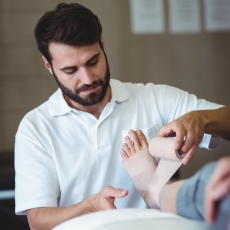

National Institutes of Health
Other Languages
Exercise Safety
Regular exercise is good for your body and safe for most everyone. However, with any type of activity, there is a chance you can get hurt. Exercise injuries can range from strains and sprains to back pain. With a little planning, you can prevent injury and stay safe during exercise.
A sprain is a stretched or torn ligament. Ligaments are tissues that connect bones at a joint. Falling, twisting, or getting hit can all cause a sprain. Ankle and wrist sprains are common. Symptoms include pain, swelling, bruising, and being unable to move your joint. You might feel a pop or tear when the injury happens.
A strain is a stretched or torn muscle or tendon. Tendons are tissues that connect muscle to bone. Twisting or pulling these tissues can cause a strain. Strains can happen suddenly or develop over time. Back and hamstring muscle strains are common. Many people get strains playing sports. Symptoms include pain, muscle spasms, swelling, and trouble moving the muscle.
At first, treatment of both sprains and strains usually involves resting the injured area, icing it, wearing a bandage or device that compresses the area, and medicines. Later treatment might include exercise and physical therapy.
NIH: National Institute of Arthritis and Musculoskeletal and Skin Diseases
- MRI of the Musculoskeletal System(American College of Radiology, Radiological Society of North America)Also in Spanish
- Musculoskeletal Ultrasound (American College of Radiology, Radiological Society of North America)Also in Spanish
- Stretching Safely and Effectively (Mayo Foundation for Medical Education and Research)Also in Spanish
- How to Care for a Sprained Ankle (American Orthopaedic Foot and Ankle Society)Also in Spanish
- Strains and Sprains (Nemours Foundation)
- How to Strengthen Your Ankle After a Sprain (American Orthopaedic Foot and Ankle Society)Also in Spanish
- How to Stretch Your Ankle After a Sprain (American Orthopaedic Foot and Ankle Society)Also in Spanish
- Mobility Aids: MedlinePlus Health Topic
 - Canes, crutches, walkers, wheelchairsAlso in Spanish
- Canes, crutches, walkers, wheelchairsAlso in Spanish
- Hamstring Injury (Mayo Foundation for Medical Education and Research)Also in Spanish
- Thumb Sprains (American Society for Surgery of the Hand)Also in Spanish
- Whiplash
 (National Institute of Neurological Disorders and Stroke)
(National Institute of Neurological Disorders and Stroke) - Wrist Sprains (American Society for Surgery of the Hand)Also in Spanish
- ClinicalTrials.gov: Sprains and Strains
 (National Institutes of Health)
(National Institutes of Health)
- Ankle Sprain Treatment (American Academy of Pediatrics)Also in Spanish
- Strains and Sprains Are a Pain (Nemours Foundation)Also in Spanish
- Ankle Sprains (Nemours Foundation)Also in Spanish
- Strains and Sprains (Nemours Foundation)
- Ankle sprain - aftercare (Medical Encyclopedia)Also in Spanish
- Elbow sprain -- aftercare (Medical Encyclopedia)Also in Spanish
- Foot sprain - aftercare (Medical Encyclopedia)Also in Spanish
- Hamstring strain - aftercare (Medical Encyclopedia)Also in Spanish
- Hip flexor strain -- aftercare (Medical Encyclopedia)Also in Spanish
- Sprains (Medical Encyclopedia)Also in Spanish
- Strains (Medical Encyclopedia)Also in Spanish
- Tendon repair (Medical Encyclopedia)Also in Spanish
- Wrist sprain - aftercare (Medical Encyclopedia)Also in Spanish
No comments:
Post a Comment